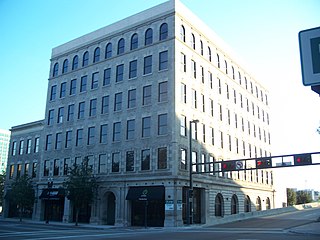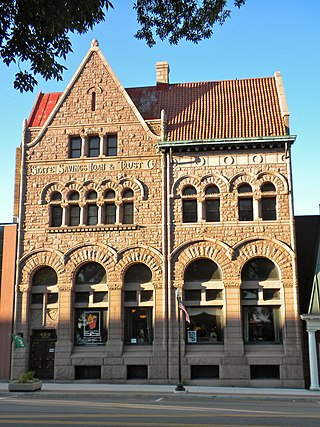
The Guardian Building is a landmark skyscraper and class-A office building in downtown Detroit, Michigan, within the Financial District. Built in 1928 and finished in 1929, the building was originally called the Union Trust Building and is a bold example of Art Deco architecture, including art moderne designs. It was designated a National Historic Landmark in 1989, and is currently owned by Wayne County.

Francis Griffith Newlands was an American politician and land developer who served as United States representative and Senator from Nevada and a member of the Democratic Party.

The Rock Creek Railway, which operated independently from 1890 to 1895, was one of the first electric streetcar companies in Washington, D.C., and the first to extend into Maryland.

Waddy Butler Wood was an American architect of the early 20th century and resident of Washington, D.C. Although Wood designed and remodeled numerous private residences, his reputation rested primarily on his larger commissions, such as banks, commercial offices, and government buildings. His most notable works include the Woodrow Wilson House and the Main Interior Building.

Edward Wilton Donn Jr. (1868–1953) was a Washington, D.C.-based American architect of the early 20th century.

The Dyal–Upchurch Building is a six-story, 43,747-square-foot historic building in Jacksonville, Florida. It is located at 4 East Bay Street, and was designed by architect Henry John Klutho. On April 17, 1980, it was added to the U.S. National Register of Historic Places.

The Bankers Trust Company Building is an office building located at 205 West Congress Street in Downtown Detroit, Michigan, within the Financial District. Designed by Wirt C. Rowland of Smith, Hinchman & Grylls and completed in 1925 the ornately modeled building is an exquisite example of Italian Romanesque Revival architecture.

The Hoge Building is a 17-story building constructed in 1911 by, and named for James D. Hoge, a banker and real estate investor, on the northwest corner of Second Avenue and Cherry Street in Seattle, Washington. The building was constructed primarily of tan brick and terracotta built over a steel frame in the architectural style of Second Renaissance Revival with elements of Beaux Arts. It was the tallest building in Seattle from 1911 to 1914, until the completion of Smith Tower.

The Kennedy–Warren is a historic eleven-story apartment house in Washington, D.C. It is located at 3131–3133 Connecticut Avenue, N.W. between the Cleveland Park and Woodley Park neighborhoods. The Art Deco building overlooks the National Zoological Park and Klingle Valley Park, which is near the Art Deco Klingle Valley Bridge. The original main building was built between 1930 and 1931 with 210 apartments.
Jarvis Hunt was a Chicago architect who designed a wide array of buildings, including railroad stations, suburban estates, industrial buildings, clubhouses and other structures.

The Detroit Financial District is a United States historic district in downtown Detroit, Michigan. The district was listed on the U.S. National Register of Historic Places on December 14, 2009, and was announced as the featured listing in the National Park Service's weekly list of December 24, 2009.

The American Security and Trust Company Building is a Neoclassical bank office in Washington, D.C., designed by the architectural firm of York and Sawyer. It was listed on the National Register of Historic Places in 1973.

The First National Bank Building is a historic building located in downtown Davenport, Iowa, United States. It was individually listed on the National Register of Historic Places in 1983. In 2020 it was included as a contributing property in the Davenport Downtown Commercial Historic District. The building is now known as the US Bank Building, its main tenant.

The Spring Valley Shopping Center is an historic shopping center, located at 4820, 4860, 4872, 4874 Massachusetts Avenue and 4301 49th Street, Northwest, Washington, D.C., in the Spring Valley neighborhood.

Francis Griffith Newlands Memorial Fountain is a historic fountain located at Chevy Chase Circle, on the border between the Chevy Chase neighborhood, Northwest, Washington, D.C., and the community of Chevy Chase, Maryland. The fountain was designed by Edward W. Donn, Jr. in 1933 and erected in 1938. Named for Francis G. Newlands, the project was funded by Newlands' widow. It is controlled and operated by the National Park Service as part of nearby Rock Creek Park.

Leon Emil Dessez was an American architect in Washington, D.C. He designed public buildings in the District of Columbia, and residences there and in Maryland, and Virginia, including some of the first in Chevy Chase, Maryland, where he was the community's first resident. His D.C. work includes the 1893 conversion of the Shepherd Centennial Building into the Raleigh Hotel and the Normal School for Colored Girls (1913), designed with Snowden Ashford.
Howard Wright Cutler (1883–1948) was an American architect known primarily for his designs of churches, schools and public buildings in Washington, D.C., and adjacent Montgomery County, Maryland.

The State National Bank Building is a high-rise office building located at 412 Main Street in downtown Houston, Texas. Designed by architect Alfred Charles Finn, the building was built in 1923 in the Spanish colonial style. It was listed on the National Register of Historic Places on August 11, 1982.

State Savings Loan and Trust is a historic bank building located at 428 Maine Street in Quincy, Illinois. The bank was built in 1892 for brothers Lorenzo and Charles H. Bull, who were prominent Quincy businessmen and community leaders. Chicago architectural firm Patton & Fisher designed the bank in the Richardsonian Romanesque style; local architect Ernest M. Wood designed an addition for the building in 1906. The building has a five-bay facade, with three bays on the original portion and two on the addition; the bays are each marked by a window with a thick stone arch. The original section is topped by a large front-facing gable, providing for attic space above the second story.

The Chevy Chase Land Company is a real estate holding and development company based in suburban Washington, D.C.





















